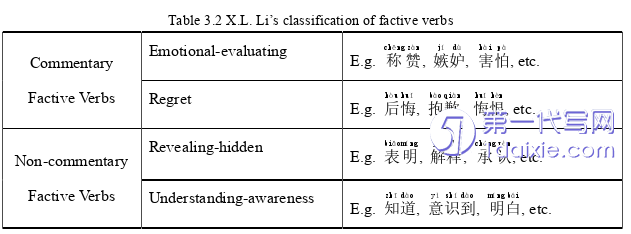本文是一篇英语论文,本文立足于汉英叙实动词的句法语义特征和构式分析,对外向型汉英学习词典中叙实动词句法表征所存在的问题提出完善意见并进行尝试性的呈现。
Chapter One INTRODUCTION
1.1 Research Objective and Background

There is a class of words that can presuppose the event expressed by the speaker is true. For example, in Chinese there are sentences such as:
A. 只zhǐ有yǒu少shǎo数shù村cūn民mín知zhī道dào这zhè种zhǒng做zuò法fǎ是shì违wéi法fǎ的de。(Only a few villagers know that this is illegal.)
B. 我wǒ记jì得de那nà一yì天tiān是shì很hěn尴gān尬gà的de。(I remember that day was very embarrassing.)
C. 他tā经jīng常cháng后hòu悔huǐ自zì己jǐ当dāng时shí没méi有yǒu把bǎ安ān全quán放fàng在zài心xīn上shàng。(He often regrets that he didn’t take safety to heart at that time.)
Sentence A presupposes the truth of the proposition “zhè zhǒng zuò fǎ shì wéi fǎ de 这种做法是违法的 (this is illegal)”; sentence B presupposes the truth of the proposition “nà yī tiān shì hěn gān gà de 那一天是很尴尬的(that day was very embarrassing)”; sentence C presupposes the truth of the proposition “zì jǐ dāng shí méi yǒu bǎ ān quán fàng zài xīn shàng自己当时没有把安全放在心上 (he didn’t take safety to heart at that time) “. Looking at the example sentences, we can see that the verbs “zhī dào 知道(know), jì de记得(remember) and hòu huǐ后悔(regret)” are followed by sentences that state facts. These verbs are often referred to as “factive verbs”, which have the distinct syntactic-semantic feature of being followed by a sentence describing facts.
1.2 Theoretical Foundation
Cognitive linguistics-based lexicographic research has emerged in the last 20 years.
Cognitive Lexicography can be defined as a new paradigm of lexicographic research that takes the Embodied Philosophy as its philosophical foundation, Cognitive Linguistics as its theoretical foundation, the process and results of various types of lexicography and its related factors as its research object, the annotation, exemplifications and labeling in the micro-structure of lexicography as its research focus, and the investigation of usage patterns based on a corpus as its methodological features, taking into account knowledge representation and user acceptance (R.Q. Wang 1).
With the development of Cognitive Linguistics, the association between Cognitive Linguistics and lexicography has increased and the study of Cognitive Lexicography has become increasingly prominent. In 1995, Goldberg’s book Constructions: A Construction Grammar Approach to Argument Structure showed the formal emergence of Construction Grammar. Construction Grammar is a branch of Cognitive Linguistics, and Goldberg was influenced by the cognitive linguist Lakoff in refining and developing her theory of Cognitive Construction Grammar. In addition, Constructicography has been proposed in recent years. Constructicography: Construction Development across Languages complied by Lyngfelt, Borin, Ohara and Torrent in 2018 realized an effective combination of Construction Grammar and lexicography and was a seminal work in the study of Constructicography.
Chapter Two LITERATURE REVIEW
2.1 Previous Studies on Factive Verbs
Scholars in the field of factive verbs have conducted extensive research, covering various aspects of factive verbs. This section reviews and discusses the research on the factuality, definition and classification of factive verbs, as well as the syntactic-semantic features of factive verbs, based on relevant research.
2.1.1Previous Studies on the Factuality
Factuality is always the focus of scholars both at home and abroad. Looking at the existing studies, we can discover that factuality is the lexical-semantic property possessed by a class of words that enables factive words to presuppose the truth of their object clauses. Studies on the factuality of English factive verbs began in 1970 when P. Kiparsky and C. Kiparsky pointed out that factive verbs differed from non-factive verbs. However, there was no clear definition on factuality and factive verbs at that time. Hooper found that factuality was different between subject and object, and divided it into true factuality and semi-factuality. This view was not mature and comprehensive, but it was a major advance that inspired other scholars to build on it. Leech, building on P. Kiparsky and C. Kiparsky’s work, further divided factuality into pure and conditional factuality, and non-factuality into non-factuality and anti-factuality, and noted that the factuality of words is not clearly delineated. This statement is reflected in recent studies about factuality.
2.2 Previous Studies on the Syntactic Representation in Dictionaries
The study on the syntactic representation of factive verbs in FCELDS begins with a discussion of the current state of verb codification in Chinese-English learner’s dictionaries. The “Big Five” English learner’s dictionaries are successful, but research shows that 95% of foreign Chinese learners do not use Chinese learner’s dictionaries published in China (L.X. Xia; Y.H. Zhang & H.J. Du; Y.L. Yang& Y. Yang). Ultimately, the codification theories and methods do not fully cater for the needs of users. This is also the case with FCELDS. X.Q. Wei pointed out that the translation of bilingual dictionaries has always been centered on the selection of equivalents, and whether the selection of equivalents is reasonable and appropriate has become a near-unique criterion for measuring the quality of translation or compilation of bilingual dictionaries. Chinese-English interpretation has been confined to the conversion that reinforces the equivalence of correspondences. This view is increasingly untenable in the light of the trend of cognitive linguistics development. W.F. Hu, after studying the current state of interpretation in mainstream Chinese-English dictionaries, pointed out that “China lacks a true Chinese-English learner’s dictionary” (41). Z.F. Long provided a general overview study of the annotation system, definition system and exemplification system of Chinese-English dictionaries, showing that Chinese-English dictionaries neglect systematization and lack reader-orientation. In fact, after the rise of cognitive linguistics and its integration into the study of lexicography, most scholars have recognized the lack of semantic networks in existing dictionaries.
Chapter Three TESTING PROCEDURE DESIGNING ..................................... 20
3.1 Syntactic-Semantic Features of Chinese Factive Verbs ....................... 21
3.2 Testing Formats Designing ........................................ 22
Chapter Four INVESTIGATION ON SYNTACTIC REPRESENTATION OF FACTIVE VERBS IN FCELDS ....................... 40
4.1 An Overview on the Syntactic Representation in Dictionaries ......................... 41
4.2 Investigation on Exemplifications of Factive Verbs.......................................... 43
Chapter Five CHINESE AND ENGLISH FACTIVE CONSTRUCTIONS ........... 53
5.1 Construction Grammar in Chinese Verbs Research .......................................... 54
5.2 Chinese Factive Construction .................... 56
Chapter Six CONSTRUCTION-BASED SYNTACTIC REPRESENTATION OF FACTIVE VERBS IN FCELDS
6.1 The Interpretation Mode of the Factive Verbs
C.L. Zhao believes that interpretation is mainly to help dictionary users activate corresponding English concepts. Chinese-English dictionary interpretation uses English equivalents as the medium to connect Chinese vocabulary with the concepts in the reader’s mental vocabulary, so as to make the reader understand the aim vocabulary. This study believes that the English interpretation part plays a role in assisting foreign learners to understand Chinese factive verbs’ information. The previous section has explained that the interpretation can reflect the syntactic information of verbs to a certain extent. This section attempts to make a preliminary attempt to explain the interpretation mode of factive verbs on the basis of previous scholars’ research and theory on the interpretation mode.
In the dictionary investigation works in chapter four, we found that the three FCELDS had different interpretation modes. The CCD (C-E) does not simply interpret the headwords, but first explains the headwords, and then translates them in English in line with Chinese interpretation. This research believes that this interpretation mode is easier for learners to understand than the simple equivalent interpretation. This interpretation mode is summarized in W.F. Hu (69-71) research, that is, “explanation interpretation” mode, which explains the cultural characteristics, cultural differences, etc.

Chapter Seven CONCLUSION
7.1 Main Findings
The main findings of this study are summarized as follows, focusing on the research questions raised in introduction.
First of all, according to previous studies, we find that the factive verbs have their unique syntactic and semantic characteristics, which can be verified according to certain test methods. Therefore, this study proposed a test procedure for selecting Chinese factive verbs. According to the subjective and objective nature of the factive verbs, this study roughly divides them into commentary and minding factive verbs, and puts forward the test formats and procedures for the two types of factive verbs. Test format for commentary factive verbs: “对于+某个事件,说话人(主语)+是+叙实谓词的态度 (for + events, speaker (subject) + be + factive verbs (adjective form))” (X.L. Li 19-43). Test format for minding factive verbs: 对于/关于+宾语小句(这一事实/事情/情况),说话人(主语)+(已经)+叙实动词+了(for (the fact that) + clausal-object, speaker (subject) + factive verbs (past tense/ perfect tense)). According to the two test formats, combined with other features of the factive verbs and corpus analysis, further improvement procedures are carried out. Finally, 63 Chinese factive verbs were selected from The Contemporary Chinese Dictionary (7th Edition).
A. Based on the 63 Chinese factive verbs selected, this study investigates the entries of factive verbs in three FCELDS. We find that there is still much room for improvement in the presentation of syntactic information of factive verbs in FCELDS. Among the three FCELDS investigated in this study, there is no uniform standard for part-of-speech tagging, and one of the three FCELDS even has no part-of-speech tagging. The part-of-speech of the headwords used in some exemplifications is inconsistent with the part-of-speech of the headwords themselves. The proportion of the sentence exemplifications of the factive verbs is low, and even some of the factive verbs are not presented with exemplifications. There are few exemplifications with clausal-objects in the existing exemplifications, which is difficult to fully display the syntactic and semantic characteristics of the factive verbs. The FCELDS lack usage information, etc.
reference(omitted)
